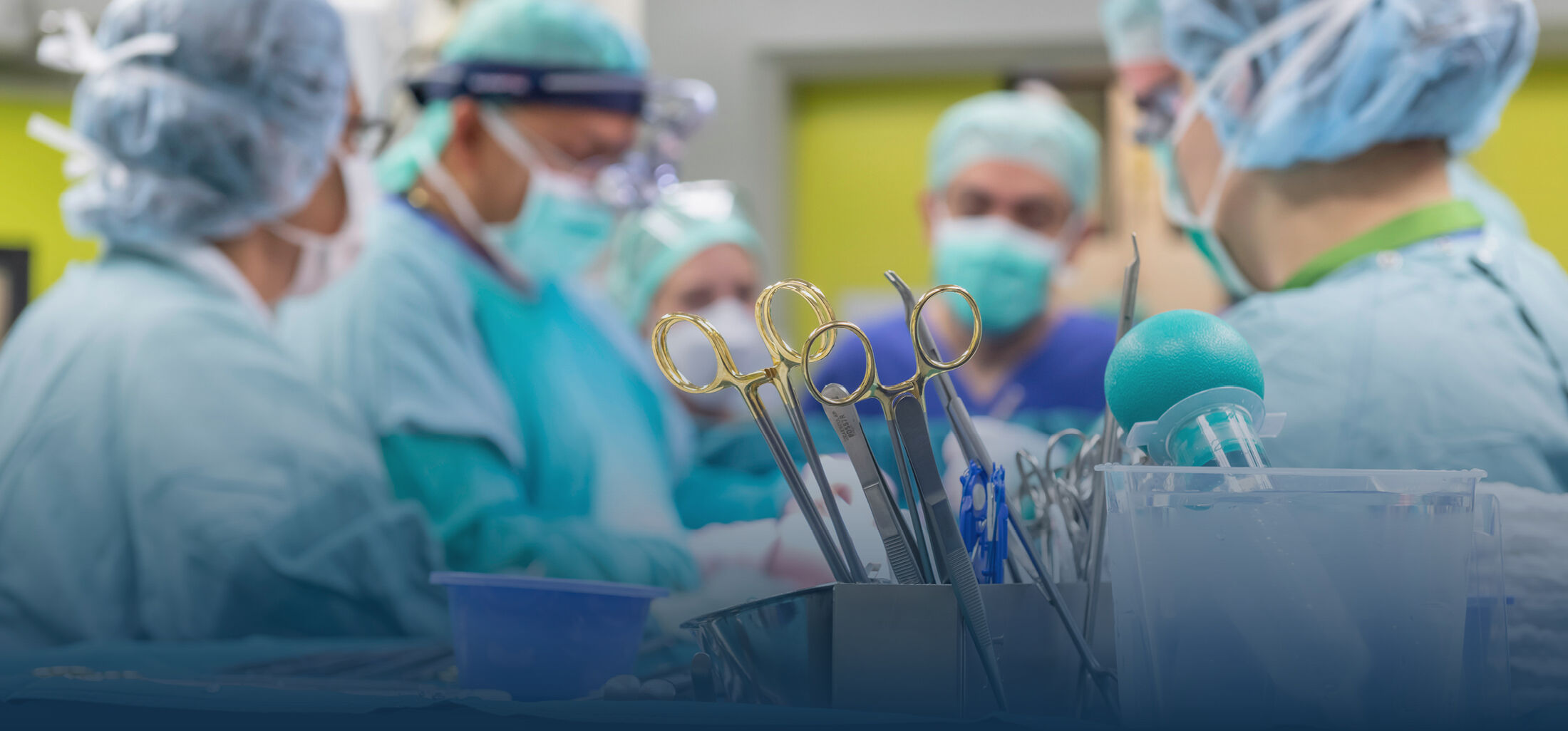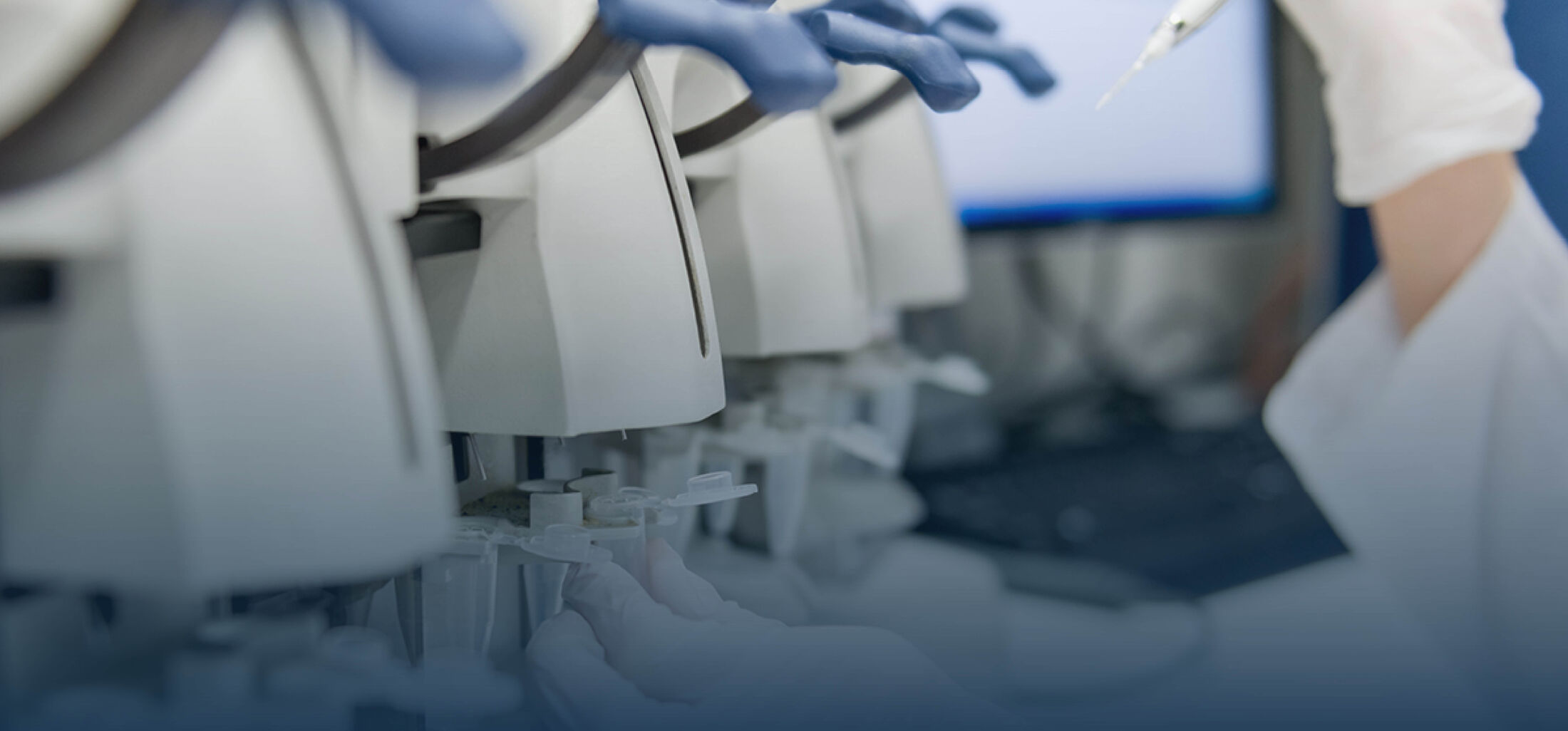Forschungsprojekte
Biomaterials for cardiovascular tissue engineering and translational research
In der kardiovaskulären Chirurgie ist in den letzten Jahren die Nachfrage nach Klappenprothesen mit dauerhaft guter Funktionalität gestiegen. Trotz der Vorteile einer besseren Hämodynamik, eines geringeren Thromboserisikos sowie einer guten Infektionsresistenz, bleibt bei biologischen Klappenprothesen das Problem der strukturellen Degeneration bestehen. Kardiovaskuläres Tissue Engineering stellt einen vielversprechenden Ansatz für gute Langzeithaltbarkeit dar.
Zur Analyse des Degenerations- und Kalzifizierungsgrades mittels Tissue Engineering hergestellter Transplantate konnte unsere Arbeitsgruppe eine Methodik der heterotopen Aortenklappen-Konduit-Implantation in Ratten etablieren. Hierbei liegt der Fokus auf der Identifizierung prodegenerativer Mediatoren. Geschlechtersensible kardiovaskuläre Medizin stehen aktuell im Mittelpunkt des Projekts.
The demand for excellent permanent functional prostheses has increased in the field of cardiovascular surgery in recent years. Despite better hemodynamics, low risk of thrombosis, and good infection resistance, structural degeneration remains a major problem. Cardiovascular tissue engineering could be a promising approach for good long-term durability.
To analyze the degeneration and calcification of tissue-engineered transplants, our research group established a method of implantation of heterotopic aortic valve conduits in rats. The overall objective is the identification of pro-degenerative mediators. Current focus is on a project working on cardiovascular gender medicine.
Extracorporeal circulation and ischemia-reperfusion injury
Bei Operationen mit einer Herz-Lungen-Maschine (HLM) und Kardioplegie führt die Ischämie sowie der Kontakt des Blutes mit künstlichen Oberflächen zu einer Aktivierung von pro-inflammatorischen und pro-apoptotischen Signalkaskaden. Im weiteren Verlauf kann sich durch diese Ischämie- und Reperfusionsschäden ein systemisches inflammatorisches Response-Syndrom (SIRS) entwickeln, was wiederum in einem Multiorganversagen resultieren kann.
Unsere Arbeitsgruppe arbeitet mit einem Kleintiermodell der extrakorporalen Zirkulation. Dabei fokussieren wir uns auf die Erforschung endogener Mediatoren sowie pharmakologischer Substanzen, die als therapeutischer Ansatz zur Verhinderung von Ischämie- und Reperfusionsschäden dienen könnten. Neben dem kardiovaskulären System wird auch der Einfluss der Ischämie und extrakorporalen Zirkulation auf weitere Organsysteme und das Gerinnungssystem untersucht.
In surgeries with extracorporeal circulation and cardioplegia, ischemia and contact of blood with synthetic surfaces activate pro-inflammatory and pro-apoptotic signal cascades. This myocardial ischemia-reperfusion injury can lead to postoperative systemic inflammatory response syndrome (SIRS), which can then result in multiorgan failure.
Our research group works with a small animal model of extracorporeal circulation. We focus on the investigation of different endogenous mediators as well as pharmacological agents as a therapeutic approach to myocardial ischemia-reperfusion injury. In addition to the cardiovascular system, we also investigate the influence of ischemia and extracorporeal circulation on other organ systems, as well as the coagulation system.
3D-bioprinting and cardiovascular tissue engineering
Additive Fertigung findet zunehmend Bedeutung in der Herzchirurgie. Dabei liegt der Fokus der Anwendung zurzeit vor allem auf der Fertigung von Modellen zur Operationsplanung und Ausbildung. Um biokompatible und lebendige Gewebegerüste (Scaffolds) zu produzieren, werden Hydrogele mittels 3D-Bioprintings hergestellt.
Unsere Arbeitsgruppe mit 3D-Bioprinting und fokussiert sich auf Modelle zur Erforschung der kalzifizierenden Aortenklappenerkrankung (CAVD). Durch kardiovaskuläres Tissue Engineering können extrazelluläre Matrices prozessiert werden, welche in Form eines Hydrogels für die 3D-Kultivierung von Zellen verwendet werden können. Auf diese Weise kann ein der nativen Klappe ähnelnde 3D-Konstrukt aus valvulären Zellen und Matrix-Komponenten zur Erforschung der Pathogenese und Therapie von Herzklappenerkrankungen ermöglicht werden.
3D bioprinting and the production of biocompatible and living tissue scaffolds is gaining importance in the field of cardiac surgery. The current focus is mostly on the production of models for surgical planning and educational purposes.
Our research group works with a 3D bioprinter and currently focusses on the establishment of a model for more detailed research of calcifying aortic valve disease (CAVD). By cardiovascular tissue engineering, 3D matrices can be created which form a hydrogel for 3D cell culture. This 3D construct mimics the native valve and serves to gain a greater understanding of the pathogenesis and therapeutic options of CAVD.
Metabolic induced cardiovascular degeneration
Kardiovaskuläre Erkrankungen sind eine der Hauptursachen für steigende Kosten im Gesundheitssystem. Die Degeneration der Aortenklappe ist hier eine der am häufigsten gestellten Diagnosen und macht einen Ersatz der betroffenen Klappe meist unumgänglich. Ein Risikofaktor für diese Erkrankung ist Diabetes mellitus - eine Erkrankung deren Prävalenz in der Bevölkerung stark zunimmt. Die Vorgänge die bei der Entstehung und Progression der Degeneration der Aortenklappe besonders in Zusammenhang mit einer diabetogenen Stoffwechsellage eine Rolle spielen sind noch weitgehend unbekannt. Unsere Arbeitsgruppe untersucht die Mechanismen und Signalwege dieser Degenerationsprozesse.
Cardiovascular diseases are a serious element in increasing costs in health care systems. The degenerative aortic valve disease is the leading diagnose and a replacement of the valve is often indispensable. Diabetes mellitus is one of the risk factors of the disease and will be in focus of cardiovascular research since its prevalence is rising. The processes taking place in the development and progression of the degenerative aortic valve disease particularly in relation to Diabetes mellitus are still not fully understood yet. Our working group investigates the mechanisms and signaling pathways of these degenerative processes.
Calcific aortic valve disease – metabolism and pathomechanism
Die Aortenklappenstenose ist das häufigste behandlungsbedürftige Klappenvitium. Zusätzlich stellt eine Degeneration biologischer Klappenprothesen ein führendes Problem in der Herzchirurgie dar. Ursächlich hierfür ist ein aktiver irreversibler Pathomechanismus: Calcific aortic valve disease (CAVD). Durch eine Inhibition treibender Faktoren des Degenerationsprozesses könnte langfristig eine Stenosierung, sowohl einer nativen Klappe als auch einer Klappenprothese, unterbunden werden.
Unsere Arbeitsgruppe arbeitet daher an der Identifikation prodegenerativer Mediatoren und daran beteiligter Signalwege. Übergeordnetes Ziel ist die Identifikation von Schlüsselproteinen der CAVD. Aktuell im Fokus steht hier die Inhibin-Activin-Follistatin-Achse.
Aortic valve stenosis is the most common valvular disease requiring treatment. Furthermore, the degeneration of biological valve prostheses remains a major problem in cardiac surgery. The cause is an active, irreversible pathomechanism: Calcific aortic valve disease (CAVD). By inhibiting factors driving the degeneration process, stenosis of a native valve as well as a valve prosthesis could be prevented.
Our group is working on the identification of pro-degenerative mediators and involved signaling pathways. Overall objective is the identification of key proteins of CAVD. Current focus is inhibin-activin-follistatin axis.
Förderungen/Grants
Deutsche Forschungsgemeinschaft (DFG), Deutsche Stiftung für Herzforschung (DSHF)
Ausgewählte Publikationen/Selected publications
- Katahira S, Sugimura Y, Grupp S, Doepp R, Selig JI, Barth M, Lichtenberg A, Akhyari P. PPAR-Gamma Activation May Inhibit the In Vivo Degeneration of Bioprosthetic Aortic and Aortic Valve Grafts under Diabetic Conditions. Int J Mol Sci. 2021 Oct 14;22(20):11081.
- Chekhoeva A, Nakanishi S, Sugimura Y, Toshmatova M, Assmann AK, Lichtenberg A, Akhyari P, Assmann A. Dichloroacetate inhibits the degeneration of decellularized cardiovascular implants. Eur J Cardiothorac Surg. 2021 Dec 27;61(1):19-26.
- Assmann AK, Goschmer D, Sugimura Y, Chekhoeva A, Barth M, Assmann A, Lichtenberg A, Akhyari P. A Role for Peroxisome Proliferator-Activated Receptor Gamma Agonists in Counteracting the Degeneration of Cardiovascular Grafts. J Cardiovasc Pharmacol. 2021 Oct 15;79(1):e103-e115.
- Sugimura Y, Chekhoeva A, Oyama K, Nakanishi S, Toshmatova M, Miyahara S, Barth M, Assmann AK, Lichtenberg A, Assmann A, Akhyari P. Controlled autologous recellularization and inhibited degeneration of decellularized vascular implants by side-specific coating with stromal cell-derived factor 1α and fibronectin. Biomed Mater. 2020 Apr 29;15(3):035013.
- Toshmatova M, Nakanishi S, Sugimura Y, Schmidt V, Lichtenberg A, Assmann A, Akhyari P. Influence of Laminin Coating on the Autologous In Vivo Recellularization of Decellularized Vascular Protheses. Materials (Basel). 2019 Oct 15;12(20):3351.
- Assmann A, Struß M, Schiffer F, Heidelberg F, Munakata H, Timchenko EV, Timchenko PE, Kaufmann T, Huynh K, Sugimura Y, Leidl Q, Pinto A, Stoldt VR, Lichtenberg A, Akhyari P. Improvement of the in vivo cellular repopulation of decellularized cardiovascular tissues by a detergent-free, non-proteolytic, actin-disassembling regimen. J Tissue Eng Regen Med. 2017 Dec;11(12):3530-3543.
- Sugimura Y, Schmidt AK, Lichtenberg A, Assmann A, Akhyari P. A Rat Model for the In Vivo Assessment of Biological and Tissue-Engineered Valvular and Vascular Grafts. Tissue Eng Part C Methods. 2017 Dec;23(12):982-994.
- Miyahara S, Jenke A, Yazdanyar M, Kistner J, Immohr MB, Sugimura Y, Aubin H, Kamiya H, Okita Y, Lichtenberg A, Akhyari P. The combination approach with Rhokinase inhibition and mechanical circulatory support in myocardial ischemia-reperfusion injury: Rho-kinase inhibition and ventricular unloading. Asian Cardiovasc Thorac Ann. 2022 Oct;30(8):894-905.
- Jenke A, Yazdanyar M, Miyahara S, Chekhoeva A, Immohr MB, Kistner J, Boeken U, Lichtenberg A, Akhyari P. AdipoRon Attenuates Inflammation and Impairment of Cardiac Function Associated With Cardiopulmonary Bypass-Induced Systemic Inflammatory Response Syndrome. J Am Heart Assoc. 2021 Mar 16;10(6):e018097.
- Pinto A, Immohr MB, Jahn A, Jenke A, Boeken U, Lichtenberg A, Akhyari P. The extracellular isoform of superoxide dismutase has a significant impact on cardiovascular ischaemia and reperfusion injury during cardiopulmonary bypass. Eur J Cardiothorac Surg. 2016 Dec;50(6):1035-1044.
- Immohr MB, Dos Santos Adrego F, Teichert HL, Schmidt V, Sugimura Y, Bauer S, Barth M, Lichtenberg A, Akhyari P. 3D-bioprinting of aortic valve interstitial cells: impact of hydrogel and printing parameters on cell viability. Biomed Mater. 2022 Nov 11;18(1).
- Selig JI, Krug HV, Küppers C, Ouwens DM, Kraft FA, Adler E, Bauer SJ, Lichtenberg A, Akhyari P, Barth M. Interactive contribution of hyperinsulinemia, hyperglycemia, and mammalian target of rapamycin signaling to valvular interstitial cell differentiation and matrix remodeling. Front Cardiovasc Med. 2022 Oct 31;9:942430.
- Barth M, Mrozek L, Niazy N, Selig JI, Boeken U, Sugimura Y, Kalampokas N, Horn P, Westenfeld R, Kröpil P, Aubin H, Lichtenberg A, Akhyari P. Degenerative changes of the aortic valve during left ventricular assist device support. ESC Heart Fail. 2022 Feb;9(1):270-282.
- Selig JI, Boulgaropoulos J, Niazy N, Ouwens DM, Preuß K, Horn P, Westenfeld R, Lichtenberg A, Akhyari P, Barth M. Crosstalk of Diabetic Conditions with Static Versus Dynamic Flow Environment-Impact on Aortic Valve Remodeling. Int J Mol Sci. 2021 Jun 28;22(13):6976.
- Selig JI, Ouwens DM, Raschke S, Thoresen GH, Fischer JW, Lichtenberg A, Akhyari P, Barth M. Impact of hyperinsulinemia and hyperglycemia on valvular interstitial cells - A link between aortic heart valve degeneration and type 2 diabetes. Biochim Biophys Acta Mol Basis Dis. 2019 Sep 1;1865(9):2526-2537.
- Barth M, Selig JI, Klose S, Schomakers A, Kiene LS, Raschke S, Boeken U, Akhyari P, Fischer JW, Lichtenberg A. Degenerative aortic valve disease and diabetes: Implications for a link between proteoglycans and diabetic disorders in the aortic valve. Diab Vasc Dis Res. 2019 May;16(3):254-269.
- Weber A, Barth M, Selig JI, Raschke S, Dakaras K, Hof A, Hesse J, Schrader J, Lichtenberg A, Akhyari P. Enzymes of the purinergic signaling system exhibit diverse effects on the degeneration of valvular interstitial cells in a 3-D microenvironment. FASEB J. 2018 Aug;32(8):4356-4369.




